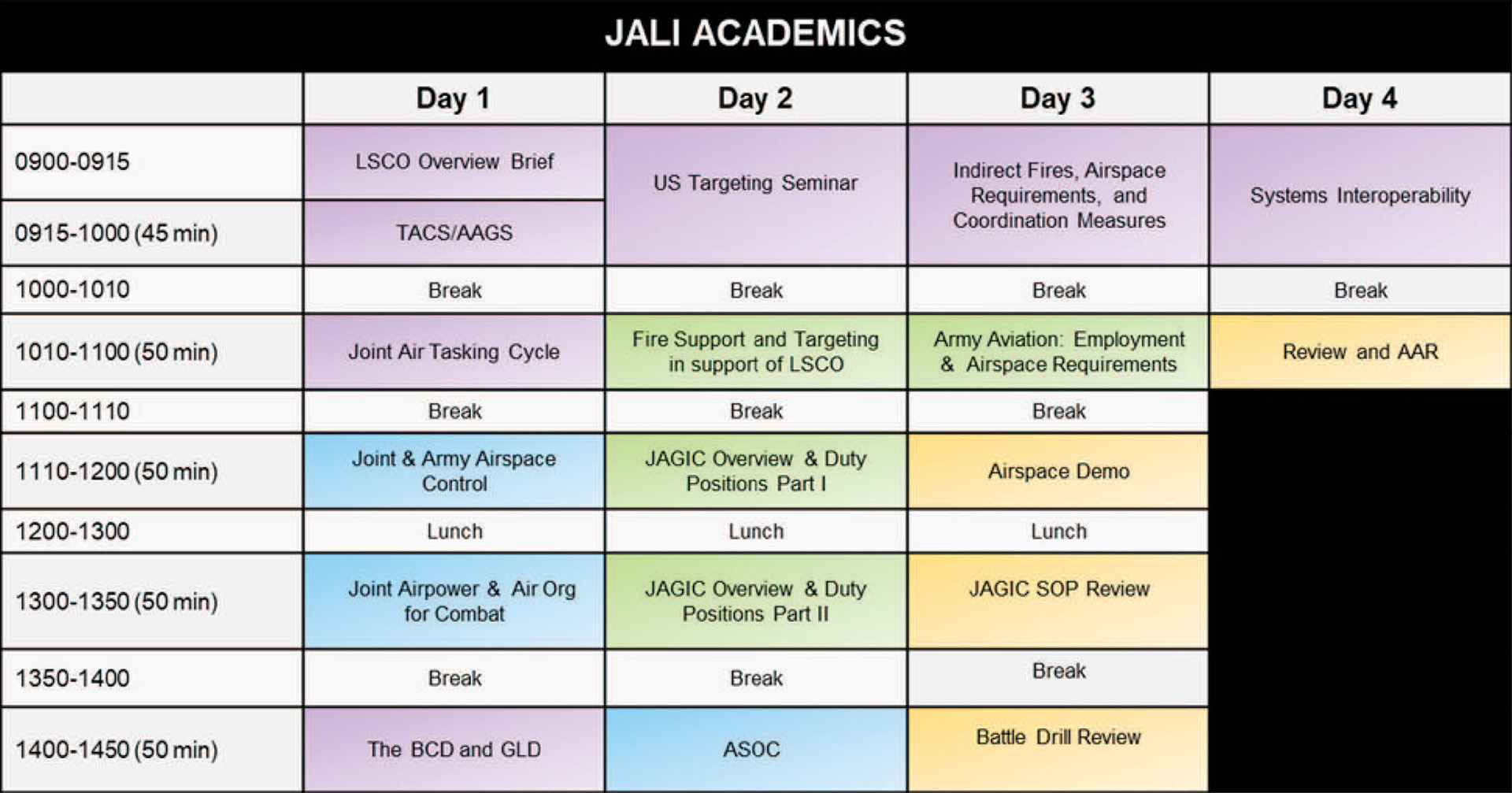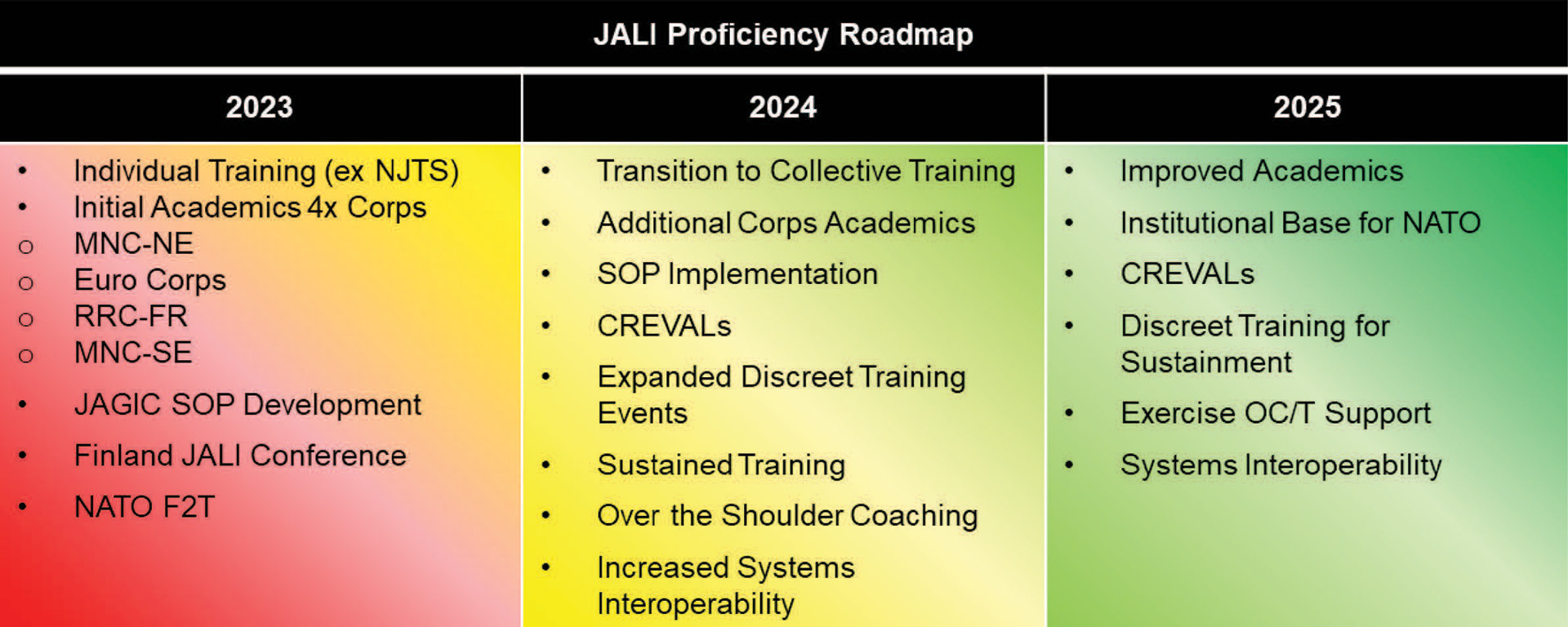Training Multinational Corps On Joint Air Land Integration
By COL Kevin Jackson, LTC Tony Dunkin and MAJ Wes Martin
Article published on: March 1, 2024 in Field Artillery 2024 Issue 1
Read Time: < 9 mins

Foreword
“Integration and interoperability are key to executing successful large-scale combat operations and vital for
survival. U.S. Army Europe and Africa (USAREUR-AF) is delivering a gated, command post centric training model
that prepares NATO Corps and Divisions to plan, coordinate and fight through the breadth and depth of today’s
battlefields. Ukraine illustrates how truly decisive this can be. The side that successfully integrates air and
land operations gains the advantage. The side that doesn’t suffers the consequences.” LTG John S. Kolasheski,
CG, V Corps.
Joint Air-Land Integration Initiative
The training and readiness of the U.S. Army and U.S. Joint Force may not be enough to win the next war alone. We
will need to fight alongside our partners and Allies to bring the strength and capabilities of a coalition to
the fight. Future U.S. Army efforts must center on the training and readiness of the entire coalition to achieve
battlefield success. The current conflict in Ukraine highlights the complexity of large-scale combat operations
(LSCO) and the need to continue to ready U.S. and coalition forces to ensure integrated deterrence or to fight
and win if called upon. Interoperability remains a constant challenge but shouldn’t prevent efforts to train
land and air forces on integrating capabilities and training staffs to fight in LSCO.
Recent changes in command structures across NATO have simplified command and control for the land and air
components. This unity of command and intuitive leadership allows subordinate commanders to lead efforts to
train and integrate more than has ever been done before in Europe. Joint air land integration is one area that
we see renewed interest and focus as we continue to learn lessons from the current conflict in Ukraine. Many
nations across the globe question how their forces could conduct air land integration in LSCO at echelon. In
short, staffs at the division and corps levels must continue to train the basic principles and find ways to
exercise and learn how to fight their formations. How then do you train both a U.S. and multinational staff
outside of a major warfighter exercise/combat readiness evaluation, or prepare them to participate and excel?
One approach to the training we are adopting in USAREUR-AF, is to develop a scalable and repeatable training
program of instruction (POI) to train these staffs. A shortfall of relevant experienced coupled with an
immediate demand for capability across NATO force structure drives the need for both short and long-term
approaches to building expertise. The basic premise is to utilize existing organizations and enhance the combat
readiness evaluation (CREVAL).
Naturally, it will take time and resources to institutionalize air land integration (ALI) training creating a
sustainable model within NATO Force Structure (NFS). While that system comes online, the immediate solution
focuses on a small mobile training team (MTT) that attempts to visit each of the ten multinational corps and
train them on air land integration. If this MTT can increase the organic capability of a corps or division to
accomplish their wartime mission, we consider this success. We also recognize this is the “commercial off the
shelf solution” and the need exists to institutionalize this process across NATO and develop doctrine and
standard operating procedures (SOPs) to promulgate lessons learned and drive change for future operations and
training.
The current four-day POI model we are implementing is based on feedback and application from one of the
multinational corps, 56th Artillery Command and the expertise from the Army Joint Support Team (AJST). AJST is
key as the foundational proponent with vetted doctrine like how U.S. divisions and corps are trained for
warfighter preparation, that can be applied across theater. Both U.S. and NATO air components, U.S. Air Force in
Europe (USAFE-AFAFRICA) and Allied Air Command (AIRCOM), are also major players in providing subject matter
expertise in their portions of the POI. The expertise of NATO’s Deployable Air Command and Control Centre
(DACCC) is also key for utilizing this 4-day POI model and ensuring NATO doctrine and processes are permeated
throughout this training. The 19th Battlefield Coordination Detachment, who interfaces with all the various
elements and maintains a Battlefield Coordination Detachment/ Ground Liaison Element (BCD/GLE) inside of AIRCOM
and USAFE, is coordinating across all the players to strengthen this effort. The 19th BCD’s relationship with
organic USAREUR-AF corps and divisions allows for synchronization of those units’ air land integration efforts
with both Allied Land Command (LANDCOM), AIRCOM, USAFEAFAF and USAREUR-AF. The goal is to create a POI and
establish Joint Air Ground Integration Center (JAGIC) SOPs that could be utilized by any partner nation in
Europe or multinational corps to increase their war fighting ability.
The four-day model explained:

Day 1: Key concepts of the operational level and organizational structure that enable air-land
integration. Creating a baseline understanding of the players and concepts necessary to enable execution of
air-land operations across all echelons. This day creates common understanding of influences above the corps
level and what entities and systems drive joint force synchronization.
Day 2: The key theme for the day is the transition down to the tactical level where JAGIC or
similar tactics, techniques and procedures (TTPs) are utilized to enable air-land operations. The lead in topic
of targeting at echelon and its importance in influencing the LSCO fight. This day introduces organizations to
concepts necessary to the ergonomics of synchronizing all airspace usage with procedural control to best enable
the commander to shape with air-land operations.
Day 3: This day focuses on the measures and controls necessary for synchronization. To enhance
understanding and build the team, a specific scenarios emphasizes the importance of the skills need and
arrangement of the cell.
Day 4: This day will focus on the topic of systems interoperability. Various NATO organizations
based on country specific systems and training expertise require robust federated mission networking solutions
to effectively communicate. The training concludes with a review and AAR to refine the POI for other
organizations and discussion on developing a sustained training plan.
Beyond Academic Foundations
The logical progression of training for NATO Corps is development of individual skill proficiency for the staff
team. This can be gained through a variety of training sources including National Institutional Training, NATO
Schools and unit on the job training. Beyond the individual level the progression to collective training
requires more deliberate planning and resourcing. Opportunities available during the near term, short of tier
one exercises, include AIRCOM Find, Fix, Track (F2T) events, USAFE Air Warfare Center (UAWC) training network
and simulation, unit level digital skills training (DST). Find, fix, track events provide a short duration
training experience with NATO air assets participating in live fly events that could scale to include land
forces participating in sequence with dynamic targeting events. USAFE Air Warfare Center operates on up to 13
different networks and has the capability of connecting remote systems to facilitate scenario-based training.
Units partnered with USAREUR rotational forces bring both experience and access to battle labs enabling DST like
training for partnered forces.

Building capability over time requires organizational experience and the ability to adapt to lessons learned. The
standard NATO model of CREVAL creates a gap between experience-based training evolutions with 10 Corps competing
for resources. To address this timing gap at unit level a more frequent stream of training experiences is
necessary to generate and maintain readiness. Future training must be frequent and specialized enough to
stimulate a JAGIC responsible for synchronizing fires and airspace during LSCO. Ideally units build and resource
training at home station to develop, refine and validate SOPs. A progression to multiple echelon DST is also an
important step in ensuring systems interoperability. Coupling of scenarios and simulations with training
objectives would provide a robust collective training program. Beyond these steps options exist leveraging the
federated mission network (FMN) connected systems to create and drive distributed discreet training events on a
reoccurring basis. This bridges the gap between individual training and CREVAL level events by inserting gated
command post centric training evolutions.
Conclusion
The NATO fight is inherently joint and multinational and to win this fight, prepared forces with the ability to
integrate land and air operations will remain key to battlefield success. We believe that foundational POI
focused on air land integration across war fighting functions with practical exercises can improve both U.S. and
multinational formations at echelon. The digital architecture and interoperability especially in NATO create
challenges, but we are confident that through low-cost repeatable training and practical monthly exercises
success can be achieved. NATO will benefit from a deliberate institutionalization of air land integration
principles and training that creates an asymmetric advantage.
Author
COL Kevin Jackson is currently the Brigade Commander for the 19th Battlefield Coordination Detachment in
Ramstein, Germany. He previously served as the Battalion Commander for 2-15 FAR and has held various joints
jobs in the Joint Staff J35 and Office of the Secretary of Defense (Policy).
LTC Anthony Dunkin is currently serving as the Joint Targeting Coordinator for 1 German Netherlands Corps in
Munster Germany. LTC Dunkin is headed to Battalion Command in Grafenwoehr, Germany in summer of 2024.
MAJ Wesley Martin is currently the Deputy Plans Chief for the 19th Battlefield Coordination Detachment in
Ramstein, Germany. He previously served as the Battalion Executive Officer for 1-94 Field Artillery Regiment
at Joint Base Lewis-McChord.